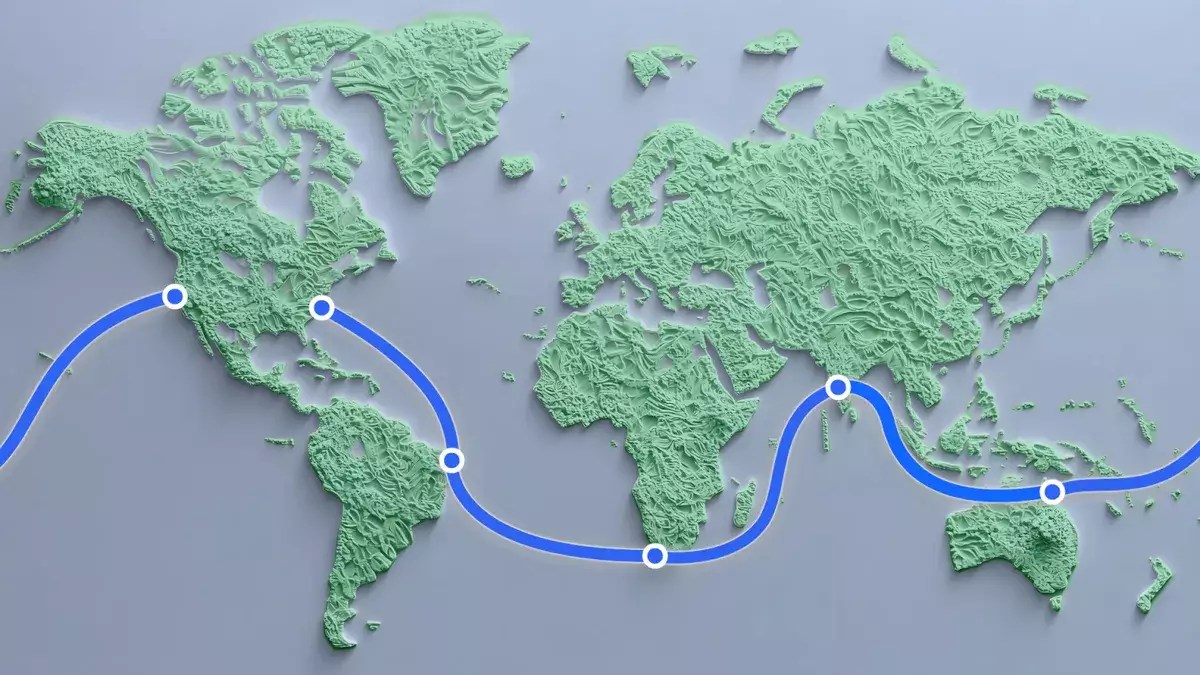In an era where wireless communication dominates the technological landscape, the underlying infrastructure that propels internet connectivity often goes unnoticed. Despite the modern inclination towards wireless solutions, it’s astounding to acknowledge that as much as 98% of global internet traffic is still transmitted through extensive physical cabling. One of the latest ventures into this realm is Meta’s ambitious underwater cable initiative, codenamed Project Waterworth. This monumental undertaking aims to stretch over 31,000 miles—surpassing the Earth’s circumference—and plunge deep into the ocean to enhance connectivity around the globe.
Project Waterworth is poised to create a remarkable network of connections linking critical regions such as the United States, India, South Africa, and Brazil. The planned route is not merely linear; it weaves across vast oceanic expanses, commencing on the US eastern coast, moving southward to Brazil, traversing the Atlantic Ocean, and skirting the southern tip of Africa. Its path then extends towards Mumbai, India, and ultimately reaches Queensland, Australia, before making its transpacific return to California. This elaborate design speaks volumes about the ever-growing need for reliable and expansive digital infrastructure as global connectivity increases.
Meta justifies this multi-billion dollar investment by emphasizing its goal to fortify the ‘digital highways’ that sustain modern society. The company envisions opening three new oceanic corridors, each tailored to facilitate high-speed data transmission in support of emerging technologies such as artificial intelligence. In a world increasingly dependent on rapid and efficient data exchange, such undertakings could define the digital future.
What sets Project Waterworth apart from previous undersea ventures is the technical ingenuity involved in its design and implementation. With segments reaching depths of nearly four miles into the ocean—a staggering 7,000 meters—Meta’s plans highlight improved resilience of the cables against environmental hazards. This includes leveraging advanced burial techniques in high-risk areas to prevent damage from natural events and human activities like shipping.
Meta’s teams are focusing on methods that allow for the efficient laying of this extensive cable while addressing the challenges posed by oceanic topography. The scale and depth of this project illustrate an ambition to not only enhance connectivity but to do so with a keen eye toward sustainability and safety.
The Broader Implications for Connectivity
The implications of such an extensive cable network extend well beyond mere numbers. As the digital landscape continues to expand, driven by societal needs for greater connectivity, the significance of such infrastructure cannot be overstated. With advancements in AI and other technologies, robust internet access will become crucial for various sectors, including healthcare, education, and global commerce.
However, it is impossible to ignore the controversies surrounding Meta’s broader operations and their impact on digital communication. Following recent public relations challenges, including criticism of the company’s moderation practices, one cannot help but question the balance between technological advancement and ethical considerations. While Project Waterworth presents an opportunity for positive developments in digital infrastructure, it also serves as a reminder of the intricate interplay between technology and social responsibility.
As the digital world continues to grow ever more complex, investments in projects like Project Waterworth become vital. The unprecedented scale of this endeavor not only aims to enhance connectivity across continents but also fosters an intricate web of potential for technologies that could reshape societies. As Meta contributes to global internet infrastructure, it simultaneously navigates the turbulent waters of public perception and responsibility.
Ultimately, the successful implementation and operation of Project Waterworth could herald a new era of connectivity—one characterized by speed, reliability, and innovative technological advancements. The project stands as a testament to the enduring significance of physical cable networks in an increasingly wireless world, reminding us that behind every wireless connection lies the silent, powerful infrastructure that not only supports our digital conversations but shapes our very reality.


Leave a Reply